Stewart J. Calculus
Подождите немного. Документ загружается.


This amounts to solving three equations in three unknowns:
Our first illustration of Lagrange’s method is to reconsider the problem given in
Example 6 in Section 15.7.
EXAMPLE 1 A rectangular box without a lid is to be made from 12 m of cardboard.
Find the maximum volume of such a box.
SOLUTION As in Example 6 in Section 15.7, we let , , and be the length, width, and
height, respectively, of the box in meters. Then we wish to maximize
subject to the constraint
Using the method of Lagrange multipliers, we look for values of , , , and such that
and . This gives the equations
which become
There are no general rules for solving systems of equations. Sometimes some ingenuity
is required. In the present example you might notice that if we multiply (2) by (3) by ,
and (4) by , then the left sides of these equations will be identical. Doing this, we have
We observe that because would imply from (2), (3), and
(4) and this would contradict (5). Therefore, from (6) and (7), we have
which gives . But (since would give ), so . From (7) and
(8) we have
which gives and so (since ) . If we now put in (5),
we get
Since , , and are all positive, we therefore have and so and . This
agrees with our answer in Section 15.7. M
y 苷 2x 苷 2z 苷 1zyx
4z
2
⫹ 4z
2
⫹ 4z
2
苷 12
x 苷 y 苷 2zy 苷 2zx 苷 02xz 苷 xy
2yz ⫹ xy 苷 2xz ⫹ 2yz
x 苷 yV 苷 0z 苷 0z 苷 0xz 苷 yz
2xz ⫹ xy 苷 2yz ⫹ xy
yz 苷 xz 苷 xy 苷 0
苷 0
苷 0
xyz 苷
共2xz ⫹ 2yz兲
8
xyz 苷
共2yz ⫹ xy兲
7
xyz 苷
共2xz ⫹ xy兲
6
z
yx,
2xz ⫹ 2yz ⫹ xy 苷 12
5
xy 苷
共2x ⫹ 2y兲
4
xz 苷
共2z ⫹ x兲
3
yz 苷
共2z ⫹ y兲
2
2xz ⫹ 2yz ⫹ xy 苷 12V
z
苷
t
z
V
y
苷
t
y
V
x
苷
t
x
t共x, y, z兲 苷 12ⵜV 苷
ⵜt
zyx
t共x, y, z兲 苷 2xz ⫹ 2yz ⫹ xy 苷 12
V 苷 xyz
zyx
2
V
t共x, y兲 苷 kf
y
苷
t
y
f
x
苷
t
x
972
||||
CHAPTER 15 PARTIAL DERIVATIVES
N Another method for solving the system of
equations (2–5) is to solve each of Equations 2,
3, and 4 for and then to equate the resulting
expressions.
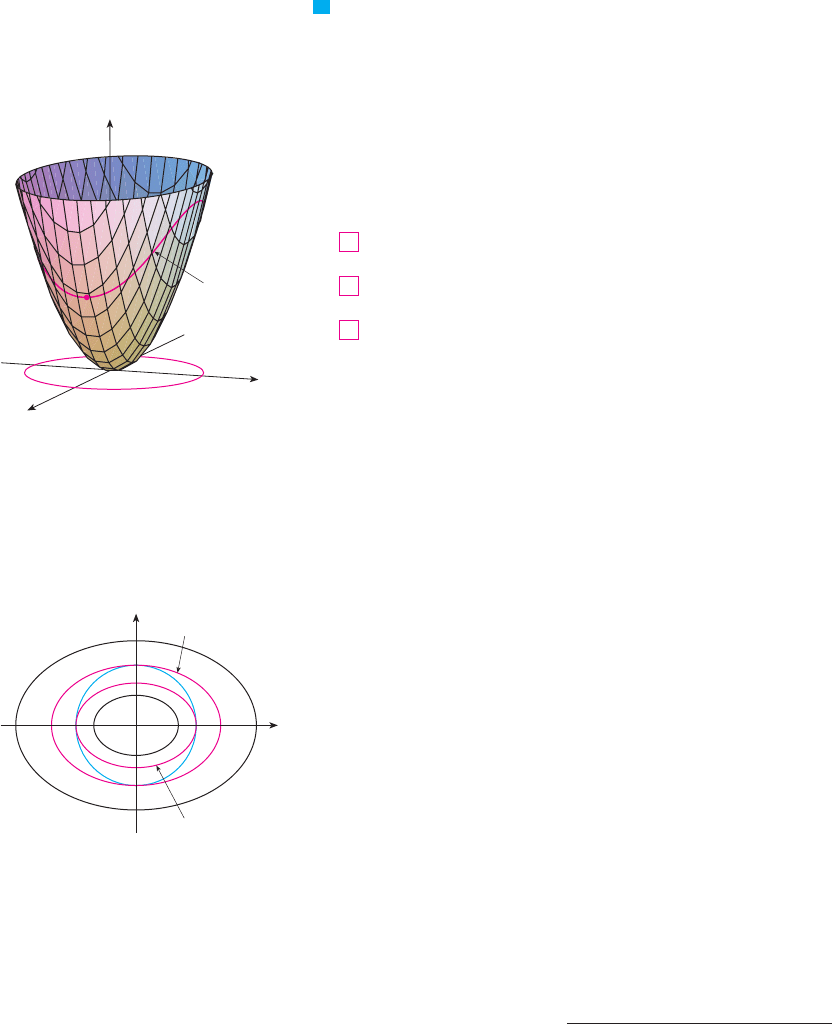
EXAMPLE 2 Find the extreme values of the function on the
circle .
SOLUTION We are asked for the extreme values of subject to the constraint
. Using Lagrange multipliers, we solve the equations
and , which can be written as
or as
From (9) we have or . If , then (11) gives . If , then
from (10), so then (11) gives . Therefore has possible extreme values
at the points , , , and . Evaluating at these four points, we
find that
Therefore the maximum value of on the circle is and the
minimum value is . Checking with Figure 2, we see that these values look
reasonable.
M
EXAMPLE 3 Find the extreme values of on the disk .
SOLUTION According to the procedure in (15.7.9), we compare the values of at the criti-
cal points with values at the points on the boundary. Since and , the only
critical point is . We compare the value of at that point with the extreme values
on the boundary from Example 2:
Therefore the maximum value of on the disk is and the
minimum value is . M
EXAMPLE 4 Find the points on the sphere that are closest to and
farthest from the point .
SOLUTION The distance from a point to the point is
but the algebra is simpler if we instead maximize and minimize the square of the
distance:
The constraint is that the point lies on the sphere, that is,
t共x, y, z兲 苷 x
2
⫹ y
2
⫹ z
2
苷 4
共x, y, z兲
d
2
苷 f 共x, y, z兲 苷 共x ⫺ 3兲
2
⫹ 共y ⫺ 1兲
2
⫹ 共z ⫹ 1兲
2
d 苷
s
共x ⫺ 3兲
2
⫹ 共y ⫺ 1兲
2
⫹ 共z ⫹ 1兲
2
共3, 1, ⫺1兲共x, y, z兲
共3, 1, ⫺1兲
x
2
⫹ y
2
⫹ z
2
苷 4
f 共0, 0兲 苷 0
f 共0, ⫾1兲 苷 2x
2
⫹ y
2
艋 1f
f 共0, ⫾1兲 苷 2f 共⫾1, 0兲 苷 1f 共0, 0兲 苷 0
f共0, 0兲
f
y
苷 4yf
x
苷 2x
f
x
2
⫹ y
2
艋 1f 共x, y兲 苷 x
2
⫹ 2y
2
f 共⫾1, 0兲 苷 1
f 共0, ⫾1兲 苷 2x
2
⫹ y
2
苷 1f
f 共⫺1, 0兲 苷 1f 共1, 0兲 苷 1f 共0, ⫺1兲 苷 2f 共0, 1兲 苷 2
f共⫺1, 0兲共1, 0兲共0, ⫺1兲共0, 1兲
fx 苷 ⫾1y 苷 0
苷 1y 苷 ⫾1x 苷 0
苷 1x 苷 0
x
2
⫹ y
2
苷 1
11
4 y 苷 2y
10
2 x 苷 2x
9
t共x, y兲 苷 1f
y
苷
t
y
f
x
苷
t
x
t共x, y兲 苷 1
ⵜf 苷
ⵜtt共x, y兲 苷 x
2
⫹ y
2
苷 1
f
x
2
⫹ y
2
苷 1
f 共x, y兲 苷 x
2
⫹ 2y
2
V
SECTION 15.8 LAGRANGE MULTIPLIERS
||||
973
N In geometric terms, Example 2 asks for the
highest and lowest points on the curve in Fig-
ure 2 that lies on the paraboloid
and directly above the constraint circle
.x
2
⫹ y
2
苷 1
z 苷 x
2
⫹ 2y
2
C
FIGURE 2
z
x
y
≈+¥=1
z=≈+2¥
C
N The geometry behind the use of Lagrange
multipliers in Example 2 is shown in Figure 3.
The extreme values of
correspond to the level curves that touch the
circle .x
2
⫹ y
2
苷 1
f 共x, y兲 苷 x
2
⫹ 2y
2
FIGURE 3
x
y
0
≈+2¥=1
≈+2¥=2
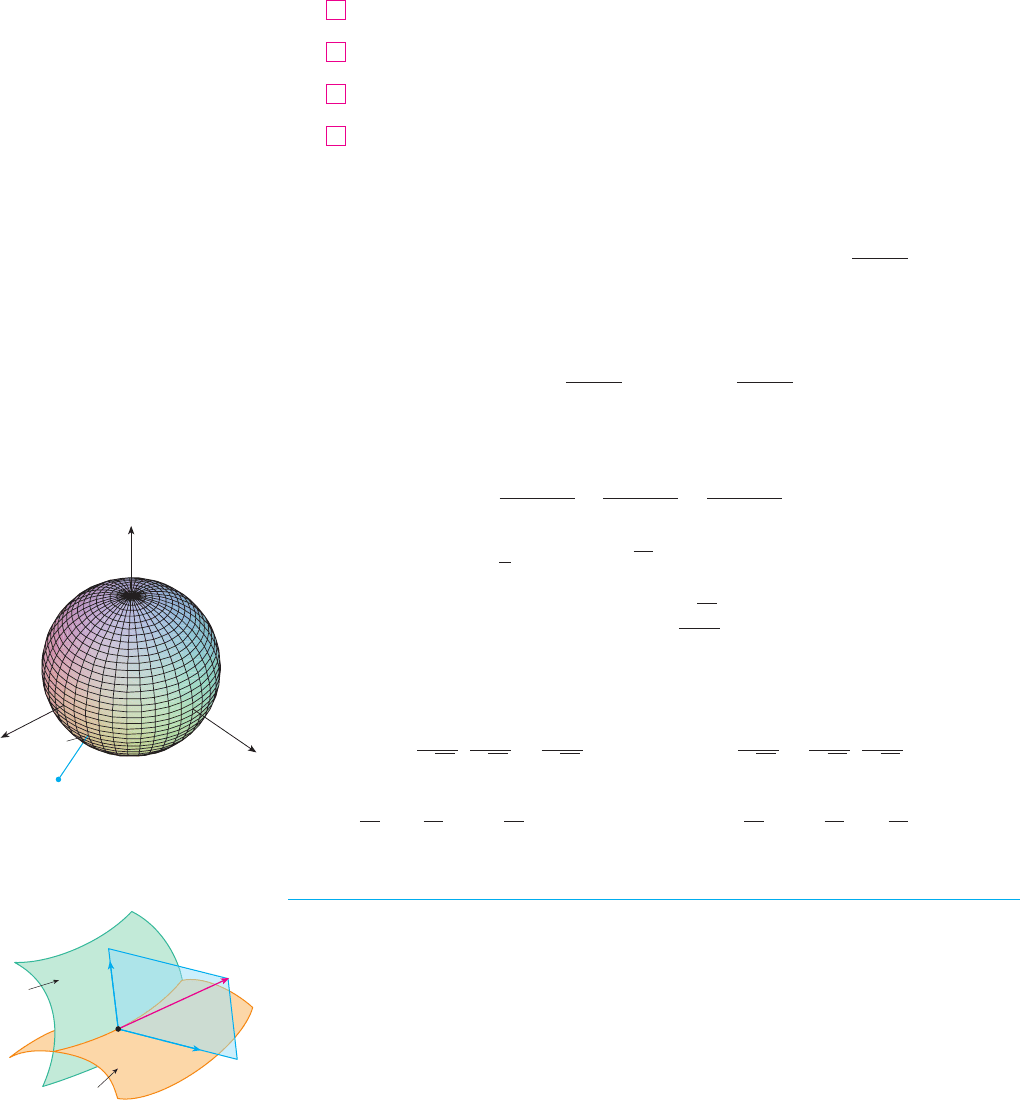
According to the method of Lagrange multipliers, we solve , . This gives
The simplest way to solve these equations is to solve for , , and in terms of from
(12), (13), and (14), and then substitute these values into (15). From (12) we have
[Note that because is impossible from (12).] Similarly, (13) and (14)
give
Therefore, from (15), we have
which gives , , so
These values of then give the corresponding points :
and
It’s easy to see that has a smaller value at the first of these points, so the closest point
is and the farthest is . M
TWO CONSTRAINTS
Suppose now that we want to find the maximum and minimum values of a function
subject to two constraints (side conditions) of the form and
. Geometrically, this means that we are looking for the extreme values of
when is restricted to lie on the curve of intersection of the level surfaces
and . (See Figure 5.) Suppose has such an extreme value at a
point . We know from the beginning of this section that is orthogonal to
at . But we also know that is orthogonal to and is orthogonal to
, so and are both orthogonal to . This means that the gradient vector
is in the plane determined by and . (We assume
that these gradient vectors are not zero and not parallel.) So there are numbers and
ⵜh共x
0
, y
0
, z
0
兲ⵜt共x
0
, y
0
, z
0
兲ⵜf 共x
0
, y
0
, z
0
兲
Cⵜhⵜth共x, y, z兲 苷 c
ⵜht共x, y, z兲 苷 kⵜtP
CⵜfP共x
0
, y
0
, z
0
兲
fh共x, y, z兲 苷 ct共x, y, z兲 苷 k
C共x, y, z兲
fh共x, y, z兲 苷 c
t共x, y, z兲 苷 kf 共x, y, z兲
(
⫺6兾
s
11, ⫺2兾
s
11, 2兾
s
11
)(
6兾
s
11, 2兾
s
11, ⫺2兾
s
11
)
f
冉
⫺
6
s
11
, ⫺
2
s
11
,
2
s
11
冊冉
6
s
11
,
2
s
11
, ⫺
2
s
11
冊
共x, y, z兲
苷 1 ⫾
s
11
2
1 ⫺
苷 ⫾
s
11兾2共1 ⫺
兲
2
苷
11
4
3
2
共1 ⫺
兲
2
⫹
1
2
共1 ⫺
兲
2
⫹
共⫺1兲
2
共1 ⫺
兲
2
苷 4
z 苷 ⫺
1
1 ⫺
y 苷
1
1 ⫺
苷 11 ⫺
苷 0
x 苷
3
1 ⫺
orx共1 ⫺
兲 苷 3orx ⫺ 3 苷 x
zyx
x
2
⫹ y
2
⫹ z
2
苷 4
15
2 共z ⫹ 1兲 苷 2z
14
2 共y ⫺ 1兲 苷 2y
13
2 共x ⫺ 3兲 苷 2x
12
t 苷 4ⵜf 苷
ⵜt
974
||||
CHAPTER 15 PARTIAL DERIVATIVES
N Figure 4 shows the sphere and the nearest
point in Example 4. Can you see how to find
the coordinates of without using calculus?P
P
FIGURE 4
z
y
x
(3,1,_1)
P
FIGURE 5
h=c
g=k
C
±g
P
±h
g
P
±h
±f
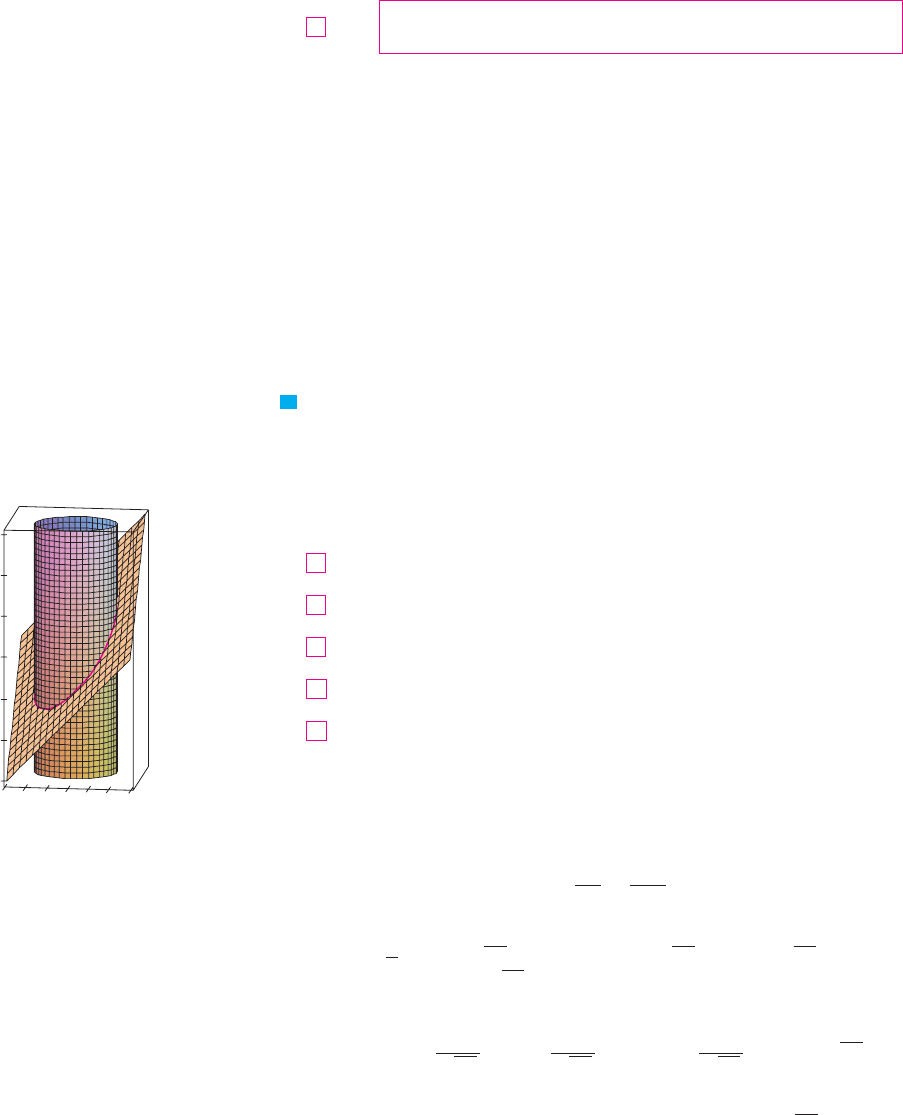
(called Lagrange multipliers) such that
In this case Lagrange’s method is to look for extreme values by solving five equations in
the five unknowns , , , , and . These equations are obtained by writing Equation 16
in terms of its components and using the constraint equations:
EXAMPLE 5 Find the maximum value of the function on the
curve of intersection of the plane and the cylinder .
SOLUTION We maximize the function subject to the constraints
and . The Lagrange condition is
, so we solve the equations
Putting [from (19)] in (17), we get , so . Similarly, (18)
gives . Substitution in (21) then gives
and so , . Then , , and, from (20),
. The corresponding values of are
Therefore the maximum value of on the given curve is . M
3 ⫹
s
29
f
⫿
2
s
29
⫹ 2
冉
⫾
5
s
29
冊
⫹ 3
冉
1 ⫾
7
s
29
冊
苷 3 ⫾
s
29
fz 苷 1 ⫺ x ⫹ y 苷 1 ⫾ 7兾
s
29
y 苷 ⫾5兾
s
29
x 苷 ⫿2兾
s
29
苷 ⫾
s
29
兾2
2
苷
29
4
1
2
⫹
25
4
2
苷 1
y 苷 5兾共2
兲
x 苷 ⫺1兾
2x
苷 ⫺2
苷 3
x
2
⫹ y
2
苷 1
21
x ⫺ y ⫹ z 苷 1
20
3 苷
19
2 苷 ⫺
⫹ 2y
18
1 苷
⫹ 2x
17
ⵜf 苷
ⵜt ⫹
ⵜh
h共x, y, z兲 苷 x
2
⫹ y
2
苷 1t共x, y, z兲 苷 x ⫺ y ⫹ z 苷 1
f 共x, y, z兲 苷 x ⫹ 2y ⫹ 3z
x
2
⫹ y
2
苷 1x ⫺ y ⫹ z 苷 1
f 共x, y, z兲 苷 x ⫹ 2y ⫹ 3z
V
h共x, y, z兲 苷 c
t共x, y, z兲 苷 k
f
z
苷
t
z
⫹
h
z
f
y
苷
t
y
⫹
h
y
f
x
苷
t
x
⫹
h
x
zyx
ⵜf 共x
0
, y
0
, z
0
兲 苷
ⵜt共x
0
, y
0
, z
0
兲 ⫹
ⵜh共x
0
, y
0
, z
0
兲
16
SECTION 15.8 LAGRANGE MULTIPLIERS
||||
975
N The cylinder intersects the
plane in an ellipse (Figure 6).
Example 5 asks for the maximum value of
when is restricted to lie on the ellipse.共x, y, z兲
f
x ⫺ y ⫹ z 苷 1
x
2
⫹ y
2
苷 1
FIGURE 6
0
y
z
_1
_2
_1
0
1
2
3
4
1
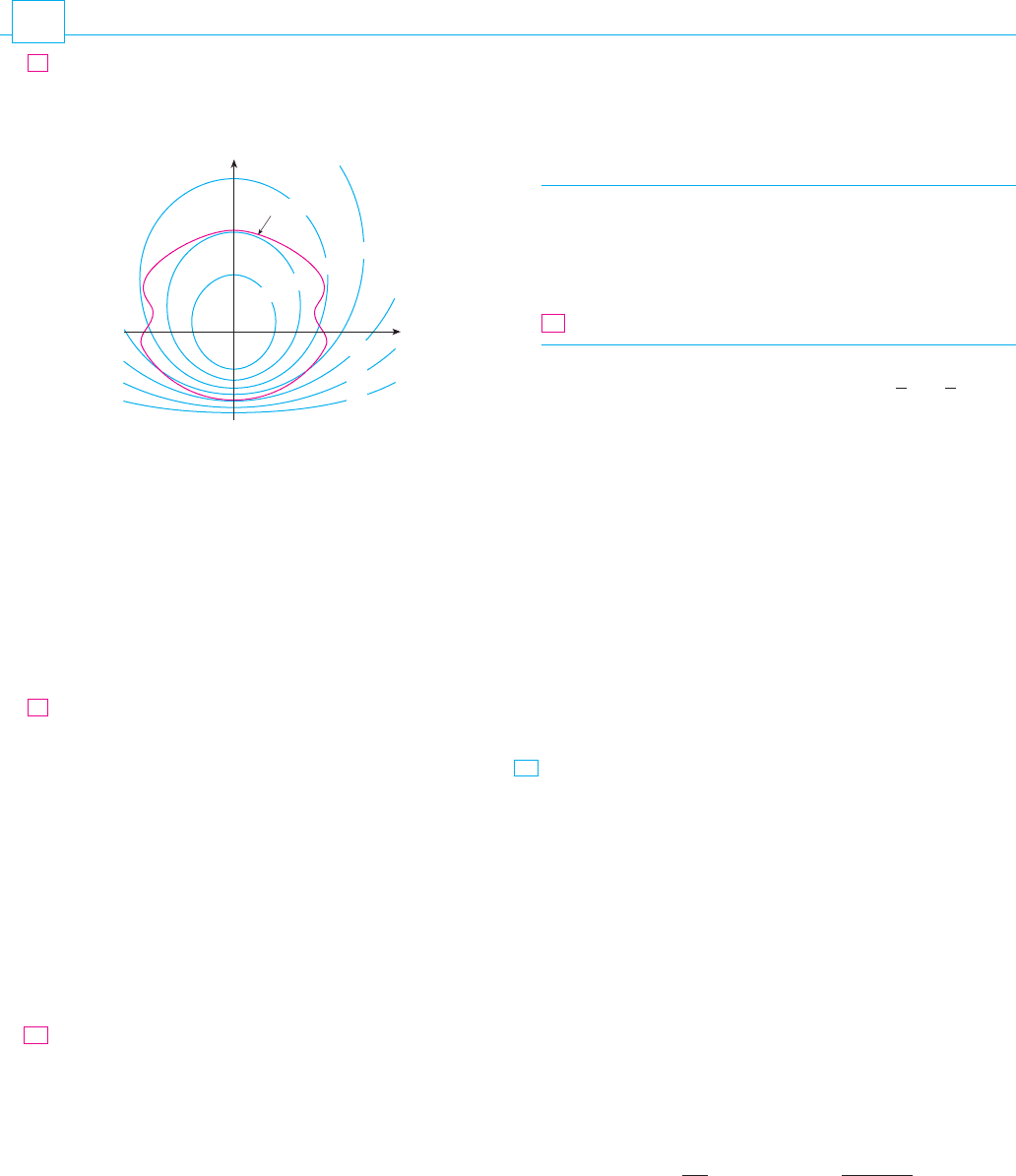
976
||||
CHAPTER 15 PARTIAL DERIVATIVES
15. ;,
16. ;
,
17. ;,
18–19 Find the extreme values of on the region described by
the inequality.
18. ,
,
20. Consider the problem of maximizing the function
subject to the constraint .
(a) Try using Lagrange multipliers to solve the problem.
(b) Does give a larger value than the one in part (a)?
;
(c) Solve the problem by graphing the constraint equation
and several level curves of .
(d) Explain why the method of Lagrange multipliers fails to
solve the problem.
(e) What is the significance of ?
21. Consider the problem of minimizing the function
on the curve (a piriform).
(a) Try using Lagrange multipliers to solve the problem.
(b) Show that the minimum value is but the
Lagrange condition is not satisfied
for any value of .
(c) Explain why Lagrange multipliers fail to find the mini-
mum value in this case.
22. (a) If your computer algebra system plots implicitly defined
curves, use it to estimate the minimum and maximum val-
ues of subject to the constraint
by graphical methods.
(b) Solve the problem in part (a) with the aid of Lagrange
multipliers. Use your CAS to solve the equations numeri-
cally. Compare your answers with those in part (a).
23. The total production of a certain product depends on the
amount of labor used and the amount of capital invest-
ment. In Sections 15.1 and 15.3 we discussed how the Cobb-
Douglas model follows from certain economic
assumptions, where and are positive constants and .
If the cost of a unit of labor is and the cost of a unit of
capital is , and the company can spend only dollars as its
total budget, then maximizing the production is subject to
the constraint . Show that the maximum
production occurs when
K 苷
共1 ⫺
␣
兲p
n
andL 苷
␣
p
m
mL ⫹ nK 苷 p
P
pn
m
␣
⬍
1
␣
b
P 苷 bL
␣
K
1⫺
␣
KL
P
共x ⫺ 3兲
2
⫹ 共y ⫺ 3兲
2
苷 9
f 共x, y兲 苷 x
3
⫹ y
3
⫹ 3xy
CAS
ⵜf 共0, 0兲 苷
ⵜt共0, 0兲
f 共0, 0兲 苷 0
y
2
⫹ x
4
⫺ x
3
苷 0
f 共x, y兲 苷 x
f 共9, 4兲
f
f 共25, 0兲
s
x
⫹
s
y
苷 5f 共x, y兲 苷 2x ⫹ 3y
x
2
⫹ 4y
2
艋 1f 共x, y兲 苷 e
⫺xy
19.
x
2
⫹ y
2
艋 16f 共x, y兲 苷 2x
2
⫹ 3y
2
⫺ 4x ⫺ 5
f
y
2
⫹ z
2
苷 1xy 苷 1f 共x, y, z兲 苷 yz ⫹ xy
x
2
⫹ 2z
2
苷 1x ⫹ y ⫺ z 苷 0
f 共x, y, z兲 苷 3x ⫺ y ⫺ 3z
y
2
⫹ z
2
苷 4x ⫹ y ⫹ z 苷 1f 共x, y, z兲 苷 x ⫹ 2y
Pictured are a contour map of and a curve with equation
. Estimate the maximum and minimum values
of subject to the constraint that . Explain your
reasoning.
;
2. (a) Use a graphing calculator or computer to graph the circle
. On the same screen, graph several curves of
the form until you find two that just touch the
circle. What is the significance of the values of for these
two curves?
(b) Use Lagrange multipliers to find the extreme values of
subject to the constraint .
Compare your answers with those in part (a).
3–17 Use Lagrange multipliers to find the maximum and
minimum values of the function subject to the given constraint(s).
;
4. ;
5. ;
6. ;
7. ;
8. ;
9. ;
10. ;
;
12. ;
13. ;
14. ;
x
2
1
⫹ x
2
2
⫹⭈⭈⭈⫹x
2
n
苷 1
f 共x
1
, x
2
, ..., x
n
兲 苷 x
1
⫹ x
2
⫹⭈⭈⭈⫹x
n
x
2
⫹ y
2
⫹ z
2
⫹ t
2
苷 1f 共x, y, z, t兲 苷 x ⫹ y ⫹ z ⫹ t
x
2
⫹ y
2
⫹ z
2
苷 1f 共x, y, z兲 苷 x
4
⫹ y
4
⫹ z
4
x
4
⫹ y
4
⫹ z
4
苷 1f 共x, y, z兲 苷 x
2
⫹ y
2
⫹ z
2
11.
x
2
⫹ y
2
⫹ z
2
苷 1f 共x, y, z兲 苷 x
2
y
2
z
2
x
2
⫹ 2y
2
⫹ 3z
2
苷 6f 共x, y, z兲 苷 xyz
x
2
⫹ 10y
2
⫹ z
2
苷 5f 共x, y, z兲 苷 8x ⫺ 4z
x
2
⫹ y
2
⫹ z
2
苷 35f 共x, y, z兲 苷 2x ⫹ 6y ⫹ 10z
x
3
⫹ y
3
苷 16f 共x, y兲 苷 e
xy
x
2
⫹ 2y
2
苷 6f 共x, y兲 苷 x
2
y
x
2
⫹ y
2
苷 13f 共x, y兲 苷 4x ⫹ 6y
xy 苷 1f 共x, y兲 苷 x
2
⫹ y
2
3.
x
2
⫹ y
2
苷 1f 共x, y兲 苷 x
2
⫹ y
c
x
2
⫹ y 苷 c
x
2
⫹ y
2
苷 1
y
x
0
70
60
50
40
30
20
10
g(x,y)=8
t共x, y兲 苷 8f
t共x, y兲 苷 8
f
1.
EXERCISES
15.8
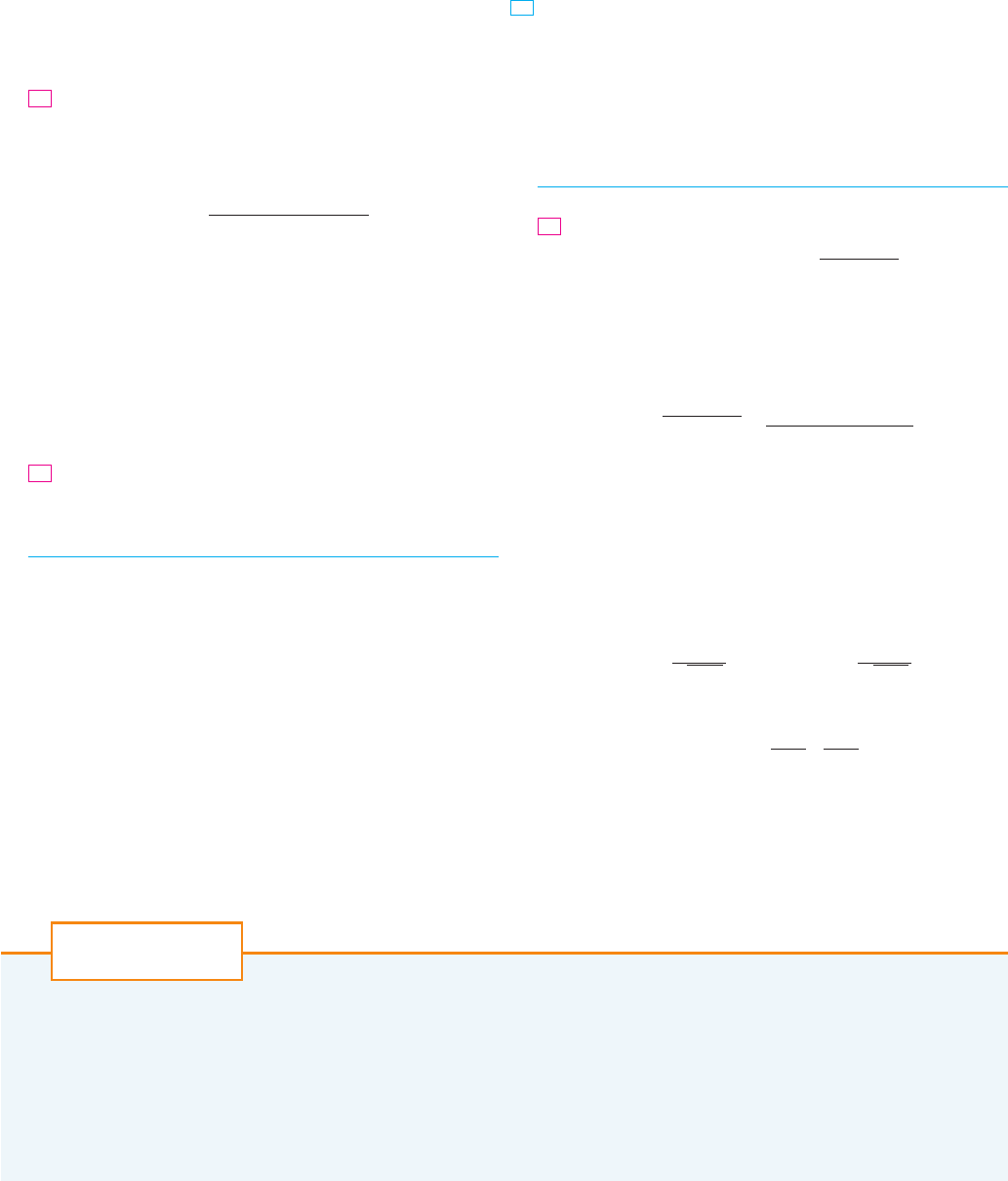
43– 44 Find the maximum and minimum values of subject to
the given constraints. Use a computer algebra system to solve the
system of equations that arises in using Lagrange multipliers. (If
your CAS finds only one solution, you may need to use additional
commands.)
43. ;,
44. ;,
(a) Find the maximum value of
given that are positive numbers and
, where is a constant.
(b) Deduce from part (a) that if are positive
numbers, then
This inequality says that the geometric mean of
numbers is no larger than the arithmetic mean of the
numbers. Under what circumstances are these two
means equal?
46. (a) Maximize subject to the constraints
and .
(b) Put
to show that
for any numbers . This inequality is
known as the Cauchy-Schwarz Inequality.
a
1
, ..., a
n
, b
1
, ..., b
n
兺
a
i
b
i
艋
s
冘
a
2
j
s
冘
b
2
j
y
i
苷
b
i
s
冘
b
2
j
x
i
苷
a
i
s
冘
a
2
j
and
冘
n
i苷1
y
i
2
苷 1
冘
n
i苷1
x
i
2
苷 1
冘
n
i苷1
x
i
y
i
n
s
n
x
1
x
2
⭈⭈⭈x
n
艋
x
1
⫹ x
2
⫹⭈⭈⭈⫹x
n
n
x
1
, x
2
, ..., x
n
cx
1
⫹ x
2
⫹⭈⭈⭈⫹x
n
苷 c
x
1
, x
2
, ..., x
n
f 共x
1
, x
2
, ..., x
n
兲 苷
s
n
x
1
x
2
⭈⭈⭈x
n
45.
x
2
⫹ z
2
苷 4x
2
⫺ y
2
苷 zf 共x, y, z兲 苷 x ⫹ y ⫹ z
xy ⫹ yz 苷 19x
2
⫹ 4y
2
⫹ 36z
2
苷 36f 共x, y, z兲 苷 ye
x⫺z
f
CAS
24. Referring to Exercise 23, we now suppose that the pro-
duction is fixed at , where is a constant.
What values of and minimize the cost function
?
Use Lagrange multipliers to prove that the rectangle with
maximum area that has a given perimeter is a square.
26. Use Lagrange multipliers to prove that the triangle with
maximum area that has a given perimeter is equilateral.
Hint: Use Heron’s formula for the area:
where and , , are the lengths of the sides.
27–39 Use Lagrange multipliers to give an alternate solution to
the indicated exercise in Section 15.7.
27. Exercise 39 28. Exercise 40
29. Exercise 41 30. Exercise 42
31. Exercise 43 32. Exercise 44
33. Exercise 45 34. Exercise 46
Exercise 47
36. Exercise 48
37. Exercise 49 38. Exercise 50
39. Exercise 53
40. Find the maximum and minimum volumes of a rectangular
box whose surface area is 1500 cm and whose total edge
length is 200 cm.
41. The plane intersects the paraboloid
in an ellipse. Find the points on this ellipse that
are nearest to and farthest from the origin.
42. The plane intersects the cone
in an ellipse.
;
(a) Graph the cone, the plane, and the ellipse.
(b) Use Lagrange multipliers to find the highest and lowest
points on the ellipse.
z
2
苷 x
2
⫹ y
2
4x ⫺ 3y ⫹ 8z 苷 5
z 苷 x
2
⫹ y
2
x ⫹ y ⫹ 2z 苷 2
2
35.
zyxs 苷 p兾2
A 苷
s
s共s ⫺ x兲共s ⫺ y兲共s ⫺ z兲
p
p
25.
C共L, K兲 苷 mL ⫹ nK
KL
QbL
␣
K
1⫺
␣
苷 Q
APPLIED PROJECT ROCKET SCIENCE
||||
977
Many rockets, such as the Pegasus XL currently used to launch satellites and the Saturn V that
first put men on the moon, are designed to use three stages in their ascent into space. A large first
stage initially propels the rocket until its fuel is consumed, at which point the stage is jettisoned
to reduce the mass of the rocket. The smaller second and third stages function similarly in order
to place the rocket’s payload into orbit about the earth. (With this design, at least two stages are
required in order to reach the necessary velocities, and using three stages has proven to be a good
compromise between cost and performance.) Our goal here is to determine the individual masses
of the three stages, which are to be designed in such a way as to minimize the total mass of the
rocket while enabling it to reach a desired velocity.
ROCKET SCIENCE
APPLIED
PROJECT
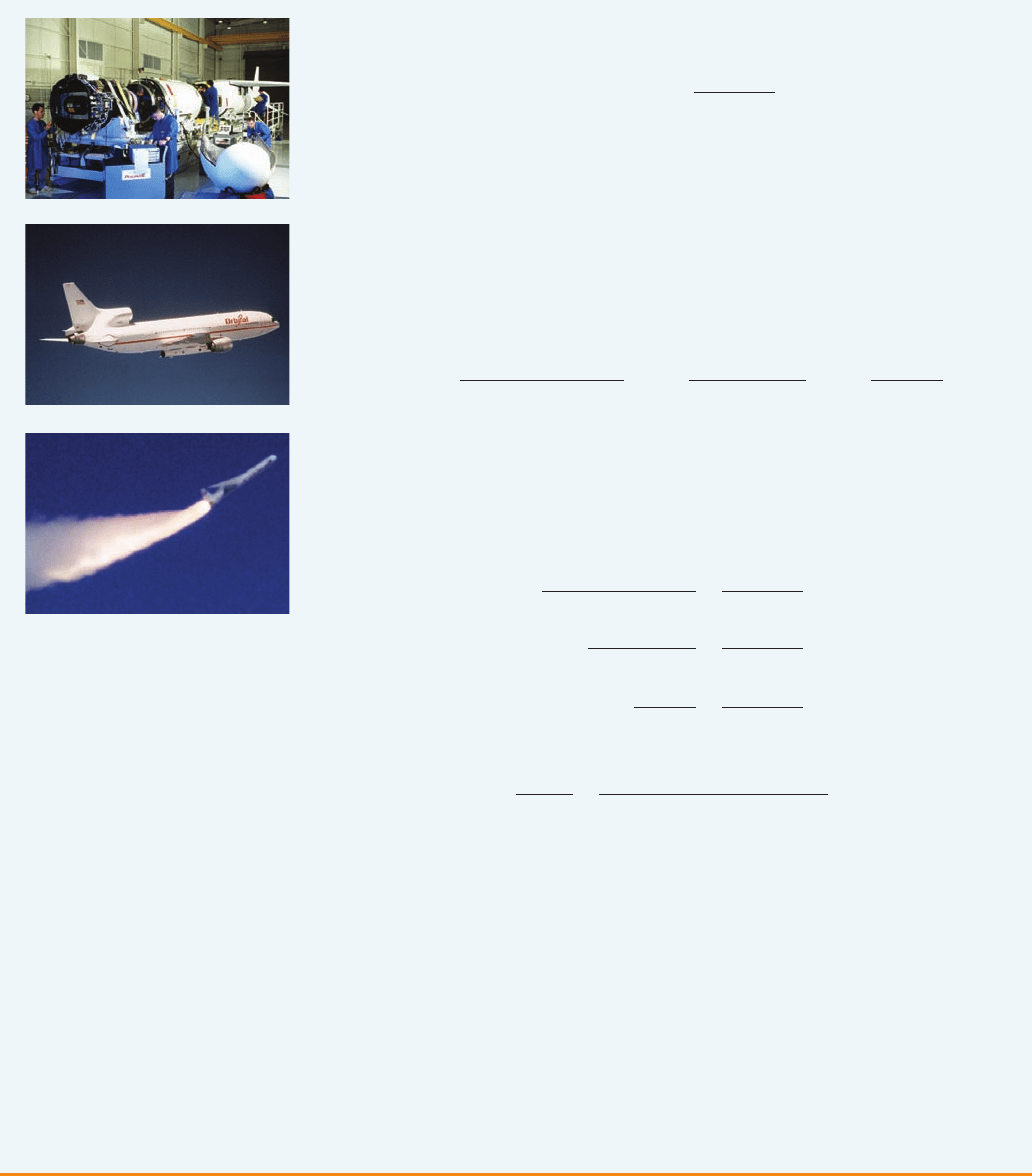
For a single-stage rocket consuming fuel at a constant rate, the change in velocity resulting
from the acceleration of the rocket vehicle has been modeled by
where is the mass of the rocket engine including initial fuel, is the mass of the payload,
is a structural factor determined by the design of the rocket (specifically, it is the ratio of the
mass of the rocket vehicle without fuel to the total mass of the rocket with payload), and is the
(constant) speed of exhaust relative to the rocket.
Now consider a rocket with three stages and a payload of mass . Assume that outside forces
are negligible and that and remain constant for each stage. If is the mass of the stage,
we can initially consider the rocket engine to have mass and its payload to have mass
; the second and third stages can be handled similarly.
1. Show that the velocity attained after all three stages have been jettisoned is given by
2. We wish to minimize the total mass of the rocket engine subject
to the constraint that the desired velocity from Problem 1 is attained. The method of
Lagrange multipliers is appropriate here, but difficult to implement using the current expres-
sions. To simplify, we define variables so that the constraint equation may be expressed as
. Since is now difficult to express in terms of the ’s, we
wish to use a simpler function that will be minimized at the same place as . Show that
and conclude that
3. Verify that is minimized at the same location as ; use Lagrange multipliers
and the results of Problem 2 to find expressions for the values of where the minimum
occurs subject to the constraint . [Hint: Use properties of
logarithms to help simplify the expressions.]
4. Find an expression for the minimum value of as a function of .
5. If we want to put a three-stage rocket into orbit 100 miles above the earth’s surface, a final
velocity of approximately is required. Suppose that each stage is built with a
structural factor and an exhaust speed of .
(a) Find the minimum total mass of the rocket engines as a function of .
(b) Find the mass of each individual stage as a function of . (They are not equally sized!)
6. The same rocket would require a final velocity of approximately in order to
escape earth’s gravity. Find the mass of each individual stage that would minimize the total
mass of the rocket engines and allow the rocket to propel a 500-pound probe into deep space.
24,700 mi兾h
A
AM
c 苷 6000 mi兾hS 苷 0.2
17,500 mi兾h
v
f
M
v
f
苷 c共ln N
1
⫹ ln N
2
⫹ ln N
3
兲
N
i
Mln共共M ⫹ A兲兾A兲
M ⫹ A
A
苷
共1 ⫺ S 兲
3
N
1
N
2
N
3
共1 ⫺ SN
1
兲共1 ⫺ SN
2
兲共1 ⫺ SN
3
兲
M
3
⫹ A
A
苷
共1 ⫺ S 兲N
3
1 ⫺ SN
3
M
2
⫹ M
3
⫹ A
M
3
⫹ A
苷
共1 ⫺ S 兲N
2
1 ⫺ SN
2
M
1
⫹ M
2
⫹ M
3
⫹ A
M
2
⫹ M
3
⫹ A
苷
共1 ⫺ S 兲N
1
1 ⫺ SN
1
M
N
i
Mv
f
苷 c共ln N
1
⫹ ln N
2
⫹ ln N
3
兲
N
i
v
f
M 苷 M
1
⫹ M
2
⫹ M
3
v
f
苷 c
冋
ln
冉
M
1
⫹ M
2
⫹ M
3
⫹ A
SM
1
⫹ M
2
⫹ M
3
⫹ A
冊
⫹ ln
冉
M
2
⫹ M
3
⫹ A
SM
2
⫹ M
3
⫹ A
冊
⫹ ln
冉
M
3
⫹ A
SM
3
⫹ A
冊册
M
2
⫹ M
3
⫹ A
M
1
ithM
i
Sc
A
c
S
PM
r
⌬V 苷 ⫺c ln
冉
1 ⫺
共1 ⫺ S兲M
r
P ⫹ M
r
冊
978
||||
CHAPTER 15 PARTIAL DERIVATIVES
Courtesy of Orbital Sciences Corporation
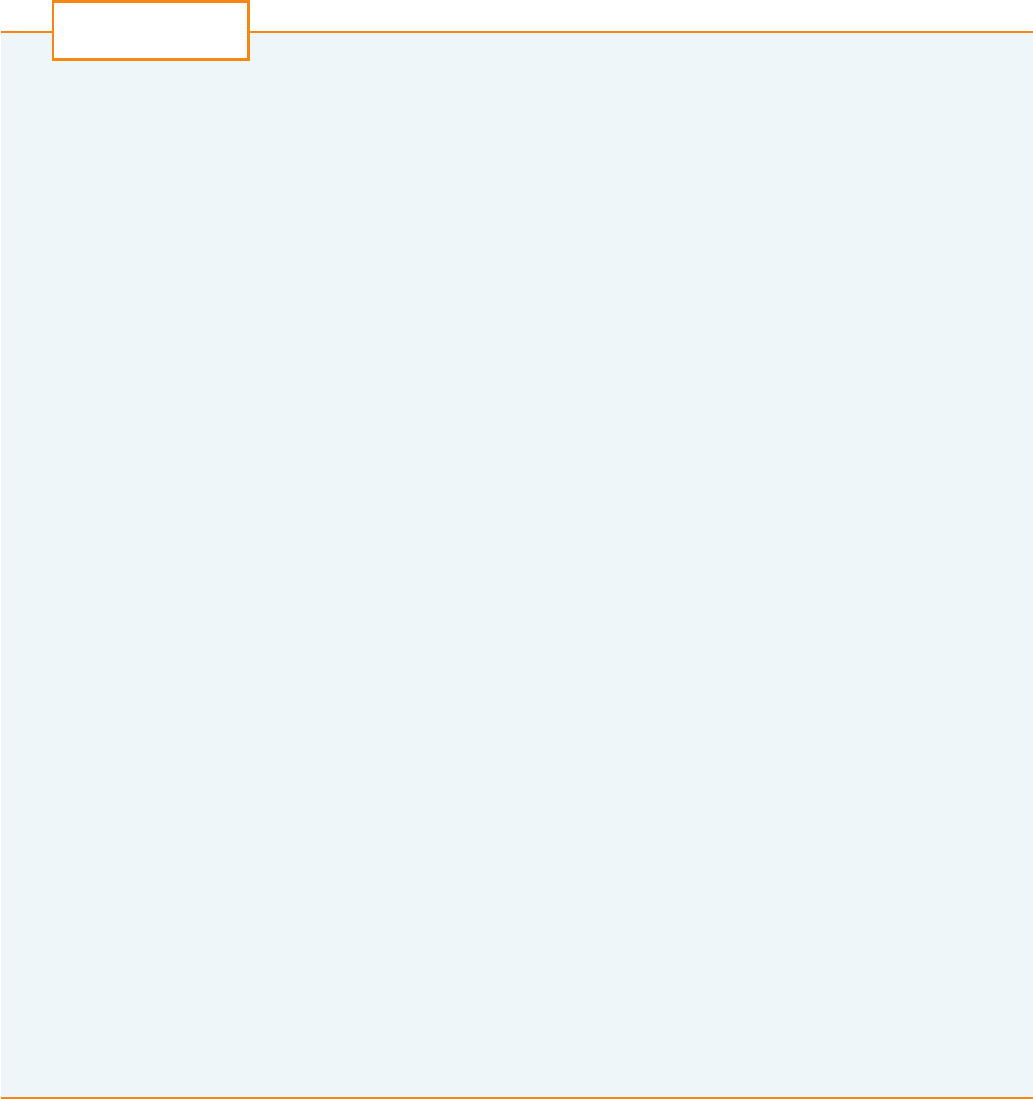
The Katahdin Paper Company in Millinocket, Maine, operates a hydroelectric generating station
on the Penobscot River. Water is piped from a dam to the power station. The rate at which the
water flows through the pipe varies, depending on external conditions.
The power station has three different hydroelectric turbines, each with a known (and unique)
power function that gives the amount of electric power generated as a function of the water flow
arriving at the turbine. The incoming water can be apportioned in different volumes to each
turbine, so the goal is to determine how to distribute water among the turbines to give the maxi-
mum total energy production for any rate of flow.
Using experimental evidence and Bernoulli’s equation, the following quadratic models were
determined for the power output of each turbine, along with the allowable flows of operation:
,,
where
1. If all three turbines are being used, we wish to determine the flow to each turbine that will
give the maximum total energy production. Our limitations are that the flows must sum to
the total incoming flow and the given domain restrictions must be observed. Consequently,
use Lagrange multipliers to find the values for the individual flows (as functions of )
that maximize the total energy production subject to the constraints
and the domain restrictions on each .
2. For which values of is your result valid?
3. For an incoming flow of , determine the distribution to the turbines and verify
(by trying some nearby distributions) that your result is indeed a maximum.
4. Until now we have assumed that all three turbines are operating; is it possible in some situa-
tions that more power could be produced by using only one turbine? Make a graph of the
three power functions and use it to help decide if an incoming flow of should be
distributed to all three turbines or routed to just one. (If you determine that only one turbine
should be used, which one would it be?) What if the flow is only ?
5. Perhaps for some flow levels it would be advantageous to use two turbines. If the incoming
flow is , which two turbines would you recommend using? Use Lagrange multi-
pliers to determine how the flow should be distributed between the two turbines to maxi-
mize the energy produced. For this flow, is using two turbines more efficient than using all
three?
6. If the incoming flow is , what would you recommend to the company?3400 ft
3
兾s
1500 ft
3
兾s
600 ft
3
兾s
1000 ft
3
兾s
2500 ft
3
兾s
Q
T
Q
i
Q
1
⫹ Q
2
⫹ Q
3
苷 Q
T
KW
1
⫹ KW
2
⫹ KW
3
Q
T
Q
i
Q
T
苷 total flow through the station in cubic feet per second
KW
i
苷 power generated by turbine i in kilowatts
Q
i
苷 flow through turbine i in cubic feet per second
250 艋 Q
3
艋 1225250 艋 Q
2
艋 1110250 艋 Q
1
艋 1110
KW
3
苷 共⫺27.02 ⫹ 0.1380Q
3
⫺ 3.84 ⴢ 10
⫺5
Q
2
3
兲共170 ⫺ 1.6 ⴢ 10
⫺6
Q
2
T
兲
KW
2
苷 共⫺24.51 ⫹ 0.1358Q
2
⫺ 4.69 ⴢ 10
⫺5
Q
2
2
兲共170 ⫺ 1.6 ⴢ 10
⫺6
Q
2
T
兲
KW
1
苷 共⫺18.89 ⫹ 0.1277Q
1
⫺ 4.08 ⴢ 10
⫺5
Q
2
1
兲共170 ⫺ 1.6 ⴢ 10
⫺6
Q
2
T
兲
HYDRO-TURBINE OPTIMIZATION
APPLIED
PROJECT
APPLIED PROJECT HYDRO-TURBINE OPTIMIZATION
||||
979

REVIEW
CONCEPT CHECK
15
12. If is defined implicitly as a function of and by an equation
of the form , how do you find and ?
13. (a) Write an expression as a limit for the directional derivative
of at in the direction of a unit vector .
How do you interpret it as a rate? How do you interpret it
geometrically?
(b) If is differentiable, write an expression for in
terms of and .
14. (a) Define the gradient vector for a function of two or
three variables.
(b) Express in terms of .
(c) Explain the geometric significance of the gradient.
15. What do the following statements mean?
(a) has a local maximum at .
(b) has an absolute maximum at .
(c) has a local minimum at .
(d) has an absolute minimum at .
(e) has a saddle point at .
16. (a) If has a local maximum at , what can you say about
its partial derivatives at ?
(b) What is a critical point of ?
17. State the Second Derivatives Test.
18. (a) What is a closed set in ? What is a bounded set?
(b) State the Extreme Value Theorem for functions of two
variables.
(c) How do you find the values that the Extreme Value
Theorem guarantees?
19. Explain how the method of Lagrange multipliers works
in finding the extreme values of subject to the
constraint . What if there is a second constraint
?h共x, y, z兲 苷 c
t共x, y, z兲 苷 k
f 共x, y, z兲
⺢
2
f
共a, b兲
共a, b兲f
共a, b兲f
共a, b兲f
共a, b兲f
共a, b兲f
共a, b兲f
ⵜfD
u
f
fⵜf
f
y
f
x
D
u
f 共x
0
, y
0
兲f
u 苷 具a, b 典共x
0
, y
0
兲f
⭸z兾⭸y⭸z兾⭸xF共x, y, z兲 苷 0
yxz
1. (a) What is a function of two variables?
(b) Describe three methods for visualizing a function of two
variables.
2. What is a function of three variables? How can you visualize
such a function?
3. What does
mean? How can you show that such a limit does not exist?
4. (a) What does it mean to say that is continuous at ?
(b) If is continuous on , what can you say about its graph?
5. (a) Write expressions for the partial derivatives and
as limits.
(b) How do you interpret and geometrically?
How do you interpret them as rates of change?
(c) If is given by a formula, how do you calculate
and
6. What does Clairaut’s Theorem say?
7. How do you find a tangent plane to each of the following types
of surfaces?
(a) A graph of a function of two variables,
(b) A level surface of a function of three variables,
8. Define the linearization of at . What is the corre-
sponding linear approximation? What is the geometric
interpretation of the linear approximation?
9. (a) What does it mean to say that is differentiable
at ?
(b) How do you usually verify that is differentiable?
10. If , what are the differentials , , and ?
11. State the Chain Rule for the case where and and
are functions of one variable. What if and are functions of
two variables?
yx
yxz 苷 f 共x, y兲
dzdydxz 苷 f 共x, y兲
f
共a, b兲
f
共a, b兲f
F共x, y, z兲 苷 k
z 苷 f 共x, y兲
f
y
?
f
x
f 共x, y兲
f
y
共a, b兲f
x
共a, b兲
f
y
共a, b兲
f
x
共a, b兲
⺢
2
f
共a, b兲f
lim
共x, y兲
l
共a, b兲
f 共x, y兲 苷 L
Determine whether the statement is true or false. If it is true, explain why.
If it is false, explain why or give an example that disproves the statement.
1.
2.
There exists a function with continuous second-order
partial derivatives such that and
.f
y
共x, y兲 苷 x ⫺ y
2
f
x
共x, y兲 苷 x ⫹ y
2
f
f
y
共a, b兲 苷 lim
y
l
b
f 共a, y兲 ⫺ f 共a, b兲
y ⫺ b
3.
4.
5.
If as along every straight line
through , then .
6. If and both exist, then is differentiable
at .共a, b兲
ff
y
共a, b兲f
x
共a, b兲
lim
共x, y兲 l 共a, b兲
f 共x, y兲 苷 L共a, b兲
共x, y兲 l 共a, b兲f 共x, y兲 l L
D
k
f 共x, y, z兲 苷 f
z
共x, y, z兲
f
xy
苷
⭸
2
f
⭸x ⭸y
TRUE-FALSE QUIZ
980
||||
CHAPTER 15 PARTIAL DERIVATIVES
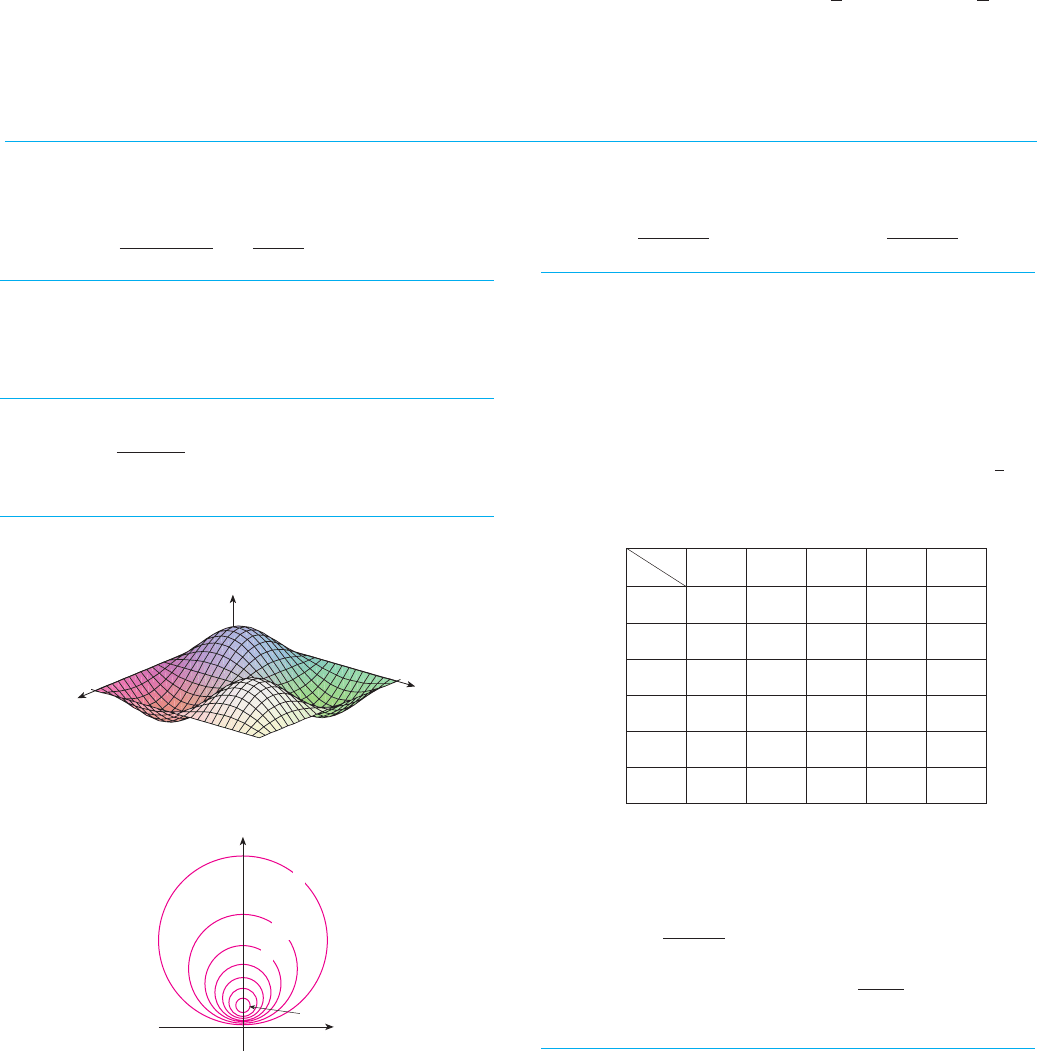
10. If is a critical point of and
then has a saddle point at .
11. If , then .
12. If has two local maxima, then must have a local
minimum.
ff 共x, y兲
⫺
s
2
艋 D
u
f 共x, y兲 艋
s
2
f 共x, y兲 苷 sin x ⫹ sin y
共2, 1兲f
f
xx
共2, 1兲 f
yy
共2, 1兲
⬍
关 f
xy
共2, 1兲兴
2
f共2, 1兲
7. If has a local minimum at and is differentiable at
, then .
8. If is a function, then
9. If , then .ⵜf 共x, y兲 苷 1兾yf 共x, y兲 苷 ln y
lim
共x, y兲 l 共2, 5兲
f共x, y兲 苷 f 共2, 5兲
f
ⵜf 共a, b兲 苷 0共a, b兲
f共a, b兲f
1–2 Find and sketch the domain of the function.
1.
2.
3– 4 Sketch the graph of the function.
3.
4.
5–6 Sketch several level curves of the function.
5.
6.
7. Make a rough sketch of a contour map for the function whose
graph is shown.
8. A contour map of a function is shown. Use it to make a
rough sketch of the graph of .
y
x
1
1.5
2
4
f
f
2
x
z
2
y
f 共x, y兲 苷 e
x
⫹ y
f 共x, y兲 苷
s
4x
2
⫹ y
2
f 共x, y兲 苷 x
2
⫹ 共y ⫺ 2兲
2
f 共x, y兲 苷 1 ⫺ y
2
f 共x, y兲 苷
s
4 ⫺ x
2
⫺ y
2
⫹
s
1 ⫺ x
2
f 共x, y兲 苷 ln共x ⫹ y ⫹ 1兲
9–10 Evaluate the limit or show that it does not exist.
9. 10.
11. A metal plate is situated in the -plane and occupies the
rectangle , , where and are measured
in meters. The temperature at the point in the plate is
, where is measured in degrees Celsius. Temperatures
at equally spaced points were measured and recorded in the
table.
(a) Estimate the values of the partial derivatives
and . What are the units?
(b) Estimate the value of , where .
Interpret your result.
(c) Estimate the value of .
12. Find a linear approximation to the temperature function
in Exercise 11 near the point (6, 4). Then use it to estimate the
temperature at the point (5, 3.8).
13–17 Find the first partial derivatives.
13. 14.
15. 16.
17.
T共 p, q, r兲 苷 p ln共q ⫹ e
r
兲
w 苷
x
y ⫺ z
t共u, v兲 苷 u tan
⫺1
v
u 苷 e
⫺r
sin 2
f 共x, y兲 苷
s
2x ⫹ y
2
T共x, y兲
30
52
78
98
96
92
38
56
74
87
90
92
45
60
72
80
86
91
51
62
68
75
80
87
55
61
66
71
75
78
x
y
0
2
4
6
8
10
0
2
4
68
T
xy
共6, 4兲
u 苷 共i ⫹ j兲兾
s
2
D
u
T共6, 4兲
T
y
共6, 4兲
T
x
共6, 4兲
TT 共x, y兲
共x, y兲
yx0 艋 y 艋 80 艋 x 艋 10
xy
lim
共x, y兲
l
共0, 0兲
2xy
x
2
⫹ 2y
2
lim
共x, y兲
l
共1, 1兲
2xy
x
2
⫹ 2y
2
EXERCISES
CHAPTER 15 REVIEW
||||
981
